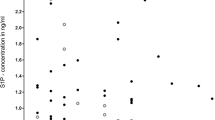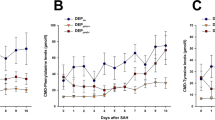Summary
The adenine nucleotide metabolites hypoxanthine, xanthine and uric acid were determined by high performance liquid chromatography in cerebrospinal fluid (CSF) from 25 patients with subarachnoid haemorrhage (SAH) and from 26 control subjects. In addition, the haemoglobin and protein levels in the CSF of the patients were determined.
In 13 subjects, from which lumbar CSF was collected three, six and nine days after SAH, there was a gradual increase in 8 patients for hypoxanthine and in 3 of the 13 patients for xanthine and uric acid. The mean concentrations were not significantly higher than the controls. In 12 SAH patients, consecutive CSF fractions of 10 ml were collected peroperatively during surgical clipping of aneurysms. The hypoxanthine concentrations increased continously from lumbar to central CSF samples. Hypoxanthine levels were 6.5±1.0 μM in lumbar CSF compared to 11.8±2.3 μM in central CSF (p<0.001), while xanthine, uric acid, haemoglobin and protein levels were equally distributed. Furthermore, the SAH patients showed about 3 times higher concentrations of central CSF hypoxanthine (p<0.01) and xanthine (p<0.05) while that for uric acid was similar compared to all control subjects. Also, an in vitro study showed that the increased concentrations of the adenine nucleotide metabolites could not be caused by degradation of blood components in the subarachnoid space.
It is presumed that the increased central CSF concentrations of hypoxanthine that were demonstrated in patients after SAH could be a sensitive marker for brain tissue ischaemia. However, since there was no correlation between the hypoxanthine levels, clinical condition or cerebral vascular diameter, other factors have to be excluded before ischaemia alone could explain the elevated central hypoxanthine levels in patients without major clinical dysfunction after SAH.
Similar content being viewed by others
References
Al-Khalidi, U. A. S., Chaglassian, T. H., The species distribution of xanthine oxidase. Biochem. J.97 (1965), 318–320.
Bergvall, U., Steiner, L., Forster, D. M. C., Early pattern of cerebral circulatory disturbances following subarachnoid hemorrhage. Neuroradiol.5 (1973), 24–32.
Briem, H., Hultman, E., Concentration of hypoxanthine in cerebrospinal fluid compared with concentrations of lactate and total amino acids. Thesis. Stockholm 1982.
Ekbom, K., Greitz, T., Carotid angiography in cluster headache. Acta Radiol. Diagn. (1969), 1–10.
Fein, J., Brain energetics and circulatory controls after subarachnoid hemorrhage. J. Neurosurg. (1976), 498–507.
Fujishima, M., Sugi, T., Choki, T., Yamaguchi, T., Omae, T., Cerebrospinal fluid and arterial lactate, pyruate and acid-base balance in patients with intracranial hemorrhages. Stroke (1975), 707–713.
Gabrielson, G., Greitz, T., Normal size of the internal carotid, middle cerebral and anterior cerebral arteries. Acta Radiol. Diagn.10 (1970), 1–10.
Grubb, R. L., Raichle, M. E., Eichling, J. O., Gado, M. H., Effects of subarachnoid hemorrhage on cerebral blood volume, blood flow and oxygen utilisation in humans. J. Neurosurg.46 (1977), 446–453.
Grubb, R. L., Cerebral hemodynamics and metabolism in subarachnoid hemorrhage and vasospasm. In: Cerebral Arterial Spasm (Wilkins, R., ed.), pp. 341–349. Baltimore 1980.
Hunt, W. E., Hess, R. M., Surgical risk as related to time of intervention in the repair of intracranial aneurysms. J. Neurosurg. (1976), 14–20.
Hällgren, R., Niklasson, F., Terent, Åkerblom, Å., Widerlöw, E., Oxypurines in cerebrospinal fluid as indices of disturbed brain metabolism. A clinical study of ischemic brain diseases. Stroke14, No. 3 (1983), 382–388.
Jenneth, B., Bond, M., Assessment of outcome after severe brain damage. Lancet (1975), 480.
Kleihues, P., Kobayashy, K., Hossman, K., Purine nucleotide metabolism in the cat brain after one hour of complete ischemia. J. Neurochem.23 (1974), 417–425.
Kreutzberg, G. W., Barron, K. D., Schubert, P., Cytochemical localisation of 5′-nucleotidase in glial plasma membranes. Brain Res.158 (1978), 247–257.
Kågström, E., Greitz, T., Hansson, J., Galera, R., Changes in cerebral blood flow after subarachnoid hemorrhage. Preceedings of the III international Congress of Neurological Surgery. Copenhagen 23–28 August 1965. International Congress series No. 110, p. 629. Amsterdam: Excerpta Medica Foundation.
Lagerkrantzer, M., Sollevi, A., Ihrestedt, L., Lindquist, C., Gordon, E., Cerebral blood flow and metabolism during adenosine induced hypotension in patients undergoing aneurysm surgery. In manuscript.
Lowry, O., Rosenbrough, N., Farr, A., Randall, J., Protein measurements with the folin phenol reagent. J. Biol. Chem.193 (1951), 265–275.
Manzke, H., Staemmler, W., Dörner, K., Increased nucleotide metabolism after cerebral convulsion. Neuropediatrics12 (1981), 119–131.
Manzke, H., Staemmler, W., Oxipurine concentration in the CSF from children with different diseases of the nervous system. Neuropediatrics12 (1981), 209–214.
McIlwain, H., Regulatory significance of the release and action of adenine derivatives in cerebral system. Biochem. Soc. Symp.36 (1972), 69–85.
McIlwain, H., Transport of adenine derivatives in tissue of the brain. Adv. Exp. Med. Biol.69 (1976), 253–264.
Meberg, A., Saugstad, O. D., Hypoxanthine in cerebrospinal fluid in children. Scand. J. clin. Lab. Invest.38 (1978), 437–440.
Millikan, C. H., Cerebral vasospasm and ruptured intracranial aneurysm. Arch. Neurol.32 (1975), 433–449.
Nordström, C.-H., Rehnchrona, S., Siesjö, B., Effect of phenobarbital in cerebral ischemia. Part II: Restitution of cerebral energy state as well as of glycolytic metabolites, citric acid cycle intermediates and associated amino acids after pronounced incomplete ischemia. Stroke9 (1978), 335–343.
Ohisalo, J. J., Murros, K., Fredholm, B. B., Hare, T. A., Concentrations of gammaaminobutyric acid and adenosine in the CSF in progressive myoclonus epilepsy without lafora's bodies. Arch. Neurol.40 (1983), 623–625.
Phillis, J. W., Kstopoulos, G. K., Adenosine as a putative transmitter in the cerebral cortex; studies with potentiators and antagonists Life Sci.17 (1975), 1085–1094.
Schweinberg, P. D., Loo, T. L., Simultaneous analysis of ATP, ADP, AMP and other purines in humn erythrocytes by HPLC. J. Chromatography181 (1980), 103–107.
Siesjö, B., Brain Energy Metabolism. Wiley and Sons Ltd. 1978.
Symond, L., Vasospasm in Neurosurgery. In: Vascular Diseases. Proceedings of the 7th Princeton Conference on Cerebrovascular Diseases (Moosy, J., Janeway, R., eds.), pp. 232–240. New York: Grune and Stratton. 1971.
Symond, L., Bell, B. A., Kendall, B. E., The relationship between vasospasm and cerebral ischemia and infarction. In: Cerebral Arterial Spasm (Wilkins, R., ed.), pp. 372–377. Baltimore: Williams and Wilkins. 1980.
Voldby, B., Enevoldsen, E. M., Intracranial pressure changes following aneurysm rupture. Art 2: Associated cerebrospinal fluid lactacidosis. J. Neurosurg.56 (1982), 197–204.
Wahlgren, N. G., Bergström, K., Determination of haem derivatives in the cerebrospinal fluid—a semiquantitative method. J. Neurol. Neurosurg. Psychiat.46 (1983), 553–568.
Welsh, F. A., Okonnor, M. J., Marzy, V. R., Pattacco, A. J., Johns, R., Factors limiting a regeneration of ATP following temporary ischemia in cat brain. Stroke13 (1982), 234–242.
Winer, B. J., Statistical principles in experimental design. Second edition. New York: McGraw Hill. 1971.
Winn, H. R., Rubio, R., Berne, R., Metabolic fate of adenosine in cerebrospinal fluid. In: Neurobiology of Cerebrospinal Fluid (Wood, J. E., ed.), pp. 591–601. Plenum Press. 1983.
Winn, H. R., Rubio, R., Berne, R., Brain adenosine concentration during hypoxia in rat. Amer. J. Physiol.241 (1981), H 235-H 242.
Zetterström, T., Verne, L., Ungerstedt, U., Tossman, U., Johnson, V., Fredholm, B. B., Purine levels in the intact brain. Studies with an implanted perfused hollow fibre. Neuroscience Letters29 (1981), 111–115.
Author information
Authors and Affiliations
Additional information
This study was supported by grants from Karolinska Institutet, the Swedish National Society against Heart and Chest disease, The Swedish Society of Medical Sciences, Wibergs Foundation, Boehringer Ingelheim and the Swedish Medical Research Council (proj. no. 7485).
Rights and permissions
About this article
Cite this article
von Holst, H., Sollevi, A. Increased concentration of hypoxanthine in human central cerebrospinal fluid after subarachnoid haemorrhage. Acta neurochir 77, 52–59 (1985). https://doi.org/10.1007/BF01402306
Issue Date:
DOI: https://doi.org/10.1007/BF01402306




